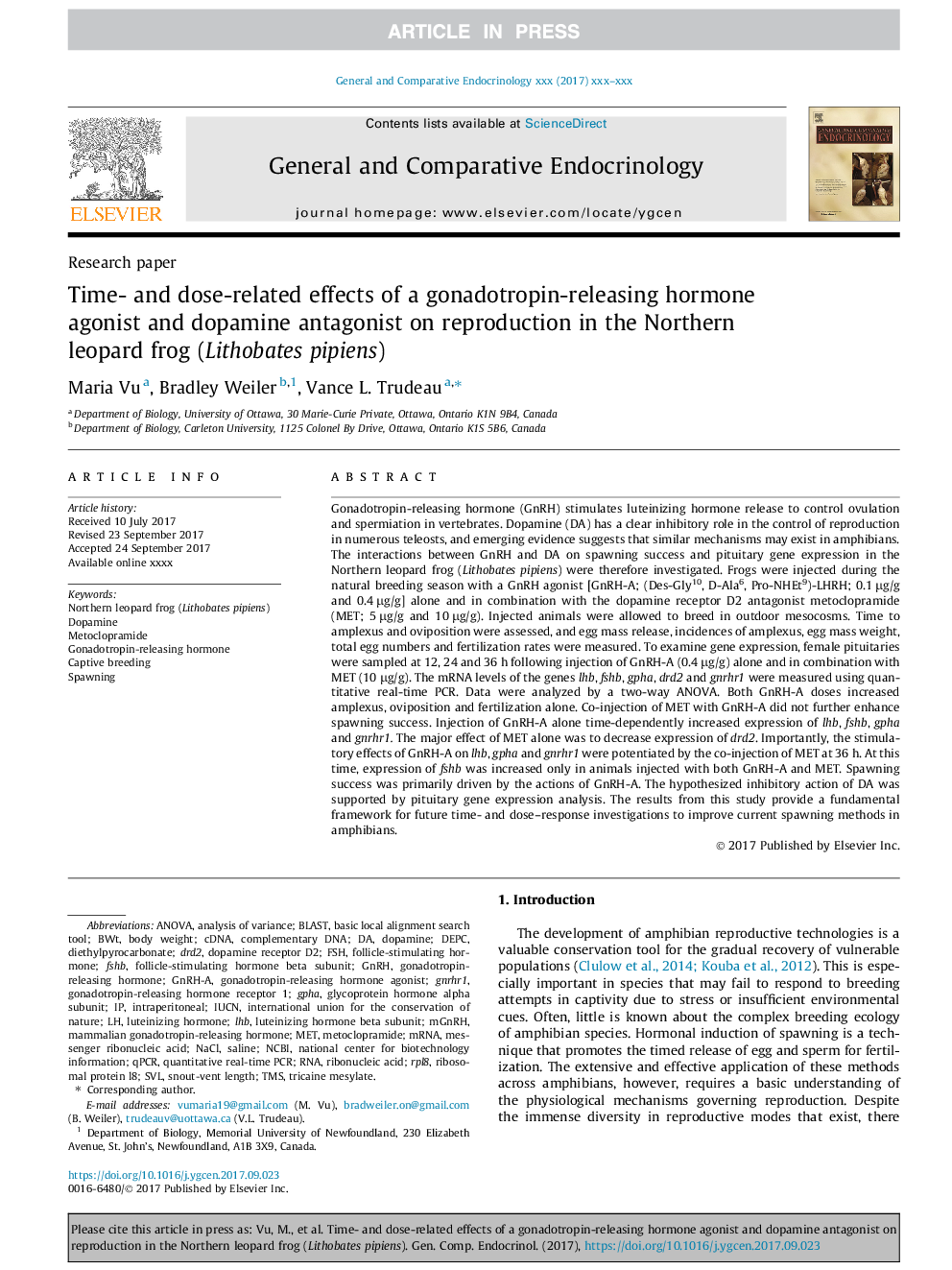| Article ID | Journal | Published Year | Pages | File Type |
|---|---|---|---|---|
| 8631496 | General and Comparative Endocrinology | 2017 | 11 Pages |
Abstract
Gonadotropin-releasing hormone (GnRH) stimulates luteinizing hormone release to control ovulation and spermiation in vertebrates. Dopamine (DA) has a clear inhibitory role in the control of reproduction in numerous teleosts, and emerging evidence suggests that similar mechanisms may exist in amphibians. The interactions between GnRH and DA on spawning success and pituitary gene expression in the Northern leopard frog (Lithobates pipiens) were therefore investigated. Frogs were injected during the natural breeding season with a GnRH agonist [GnRH-A; (Des-Gly10, D-Ala6, Pro-NHEt9)-LHRH; 0.1 μg/g and 0.4 μg/g] alone and in combination with the dopamine receptor D2 antagonist metoclopramide (MET; 5 μg/g and 10 μg/g). Injected animals were allowed to breed in outdoor mesocosms. Time to amplexus and oviposition were assessed, and egg mass release, incidences of amplexus, egg mass weight, total egg numbers and fertilization rates were measured. To examine gene expression, female pituitaries were sampled at 12, 24 and 36 h following injection of GnRH-A (0.4 μg/g) alone and in combination with MET (10 μg/g). The mRNA levels of the genes lhb, fshb, gpha, drd2 and gnrhr1 were measured using quantitative real-time PCR. Data were analyzed by a two-way ANOVA. Both GnRH-A doses increased amplexus, oviposition and fertilization alone. Co-injection of MET with GnRH-A did not further enhance spawning success. Injection of GnRH-A alone time-dependently increased expression of lhb, fshb, gpha and gnrhr1. The major effect of MET alone was to decrease expression of drd2. Importantly, the stimulatory effects of GnRH-A on lhb, gpha and gnrhr1 were potentiated by the co-injection of MET at 36 h. At this time, expression of fshb was increased only in animals injected with both GnRH-A and MET. Spawning success was primarily driven by the actions of GnRH-A. The hypothesized inhibitory action of DA was supported by pituitary gene expression analysis. The results from this study provide a fundamental framework for future time- and dose-response investigations to improve current spawning methods in amphibians.
Keywords
LHbIUCNBWTRPL8Ribosomal protein L8GnRH-aTMSDEPCfshbNCBIDRD2mRNANaClSVLqPCRGnRHInternational Union for the Conservation of NaturecDNAComplementary DNAGonadotropin-releasing hormone agonistBasic Local Alignment Search ToolRNAribonucleic acidBlastanalysis of varianceANOVAintraperitonealDopaminediethylpyrocarbonatemessenger ribonucleic acidSalinesnout-vent lengthMetoclopramideNational Center for Biotechnology InformationMETSpawningGonadotropin-releasing hormonefollicle-stimulating hormoneluteinizing hormoneFSHquantitative real-time PCRbody weightCaptive breedingdopamine receptor D2
Related Topics
Life Sciences
Biochemistry, Genetics and Molecular Biology
Endocrinology
Authors
Maria Vu, Bradley Weiler, Vance L. Trudeau,
